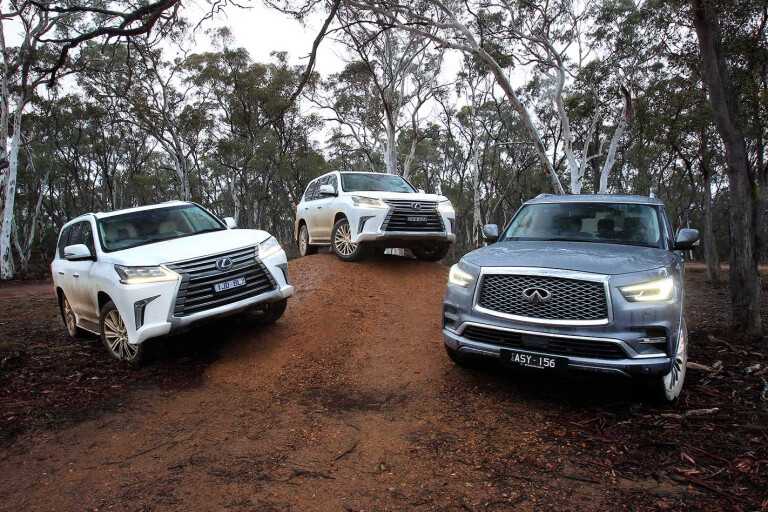
What’s in a name? Well everything, if you are Lexus or Infiniti and wishing to stand apart from your respective parents to compete in a prestige market led by the likes of Mercedes-Benz and BMW.
Well-heeled buyers interested in flash German cars aren’t likely to be tempted by middle-market brands like Toyota or Nissan, so Toyota and Nissan created their respective Lexus and Infiniti identities in 1989 following a lead by Honda, which created its own prestige brand – Acura – in 1986. Well before that, the Range Rover was created as an upmarket Land Rover, so none of this is new.
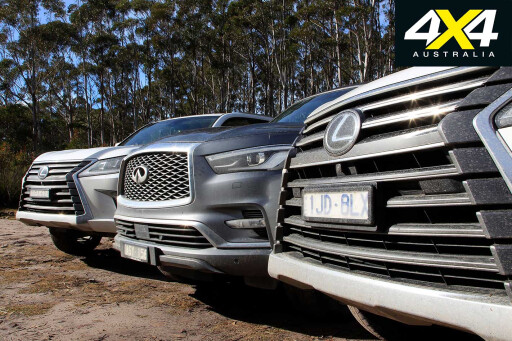 What this doesn’t mean is that the two Lexus LX models (one petrol, one diesel) and the Infiniti we have here are just two Toyotas and a Nissan with different badges. Far from it. What’s more, the degree of separation from the respective Land Cruiser 200 and Patrol Y62 donor vehicles is in fact the devil in the detail, or the sauce on the pudding, in this three-way contest.
What this doesn’t mean is that the two Lexus LX models (one petrol, one diesel) and the Infiniti we have here are just two Toyotas and a Nissan with different badges. Far from it. What’s more, the degree of separation from the respective Land Cruiser 200 and Patrol Y62 donor vehicles is in fact the devil in the detail, or the sauce on the pudding, in this three-way contest.
Of the three the Lexus LX570 is most removed from its donor vehicle with its bespoke 5.7-litre petrol V8/eight-speed powertrain not found in the LC200. Both Lexus models also get unique suspension not found on the 200, and all three have tonnes of added equipment.
The least changed from its donor vehicle, the Infiniti QX80, is the least expensive of these three, while the most changed, the LX570, is the most expensive, which helps even out the playing field.
Let the games begin...
INFINITI QX80
High-tech ‘smart’ suspension and an engine with motorsport heritage stand the QX80 in good stead.
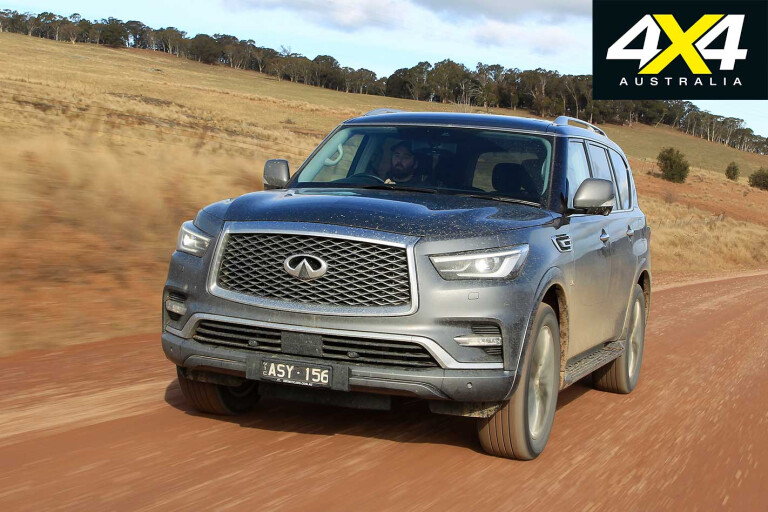
The Infiniti QX80 first arrived in Australia in mid 2015, which at the time saw a downward realignment of Patrol Y62 pricing.
What we have here is the facelifted 2018 QX80, which brings new body styling detail to both front and rear, interior and equipment tweaks, claims of lower NVH, and better fit and finish such as narrower panel gaps.
The QX80 comes at a hefty $22K premium over a top-spec (Ti-L) Patrol Y62, its donor car, but adds a fair lump of extra luxury, convenience and safety kit over the already well-stocked Ti-L. And it’s still the least expensive of the three 4x4s here.

What remains constant in all this is that the QX80, like the Y62, is a big wagon, and is even big in its overall dimensions in the company of both Lexus models, hardly small wagons themselves. A constant, too, is the familiar and impressive Hydraulic Body Motion Control (HBMC) suspension and the willing 5.6-litre petrol V8 of the Patrol Y62.
Powertrain and Performance

The QX80 is in fact more about its engine as it defines much of the way it drives and feels. Its impressive numbers – 5.6 litres, 298kW and 560Nm – give the message that it’s big and powerful, but don’t tell the whole story.
The quad-cam 32-valve V8 is state-of-the-art for a naturally aspirated petrol engine and has direct injection and variable timing and lift on the intake valves. The variable lift on the intake valves does away with the need for a conventional throttle and makes for a less restrictive intake passage.
The engine is part of Nissan’s VK V8 engine family that’s been widely used in – and in part designed for – motorsport in Japan (GT class), Europe (Le Mans prototypes) and even in Nissan’s local Supercar.

Dip hard into the QX80’s throttle and you can feel and hear this motorsport heritage and tech come to the fore. This is a light-flywheeled engine that’s revvy, eager and more than energetic enough to overcome the QX80’s considerable weight and size to be the performance leader of the three wagons here – not that the diesel Lexus is ever really in the hunt.
Shorter overall gearing than the LX570 also helps in any pedal-to-the-metal contest and the slick seven-speed automatic doesn’t let the team down with sharp full-throttle shifts.
At a more leisurely pace, the QX80’s V8 is smooth, quiet and effortless to drive without ever quite matching the LX570’s refinement.
On-Road Ride and Handling

The punchy 5.6-litre V8’s performance isn’t lost on a chassis that offers flat and surprisingly sharp on-road handling thanks to the effectiveness of the HBMC suspension.
Even on tight corners there’s hardly a hint of body roll and, for something as big and heavy as it is, the QX80 feels light, nimble and confident in the company of the heavy-feeling and often less-steady Lexus pair. The QX80’s fully independent system also plays its part here to produce a chassis that’s happier at high speeds on bumpy country roads than the rear-live-axle chassis under both LXs.
Despite the QX80’s 22-inch wheels and relatively low-profile 50-series tyres the ride comfort is surprisingly good, thanks in part to the QX80’s large wheel/tyre combination which means that even with 22s there’s still a bit of tyre sidewall. The HBMC control suspension helps here, too, as when there’s no lateral loading from cornering the suspension relaxes to provide a more comfortable ride.
Hydraulic Body Motion Control
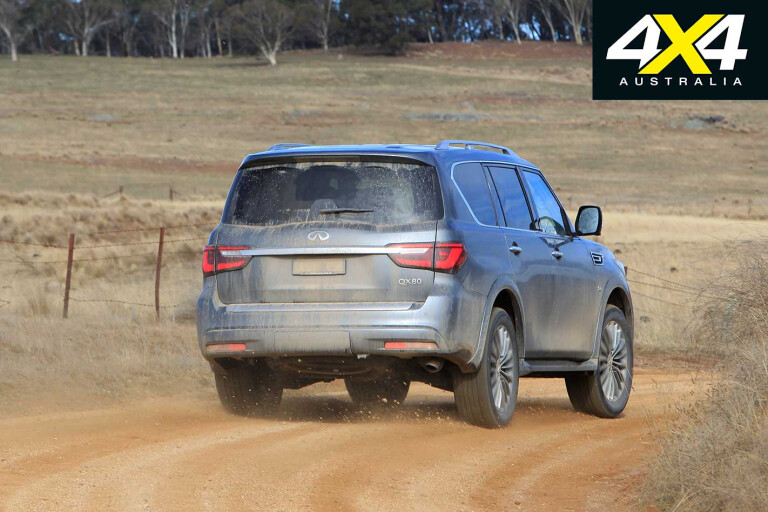
The QX80 has fully independent coil-spring suspension with what Infiniti calls Hydraulic Body Motion Control, or HBMC. In place of the usual dampers and sway bars of a conventional suspension system, HBMC has four hydraulic rams, one at each corner of the vehicle. These rams are interlinked allowing hydraulic fluid – managed by nitrogen-charged accumulators and body motion sensors – to be pumped from one to the other. In this way the wheel travel, body roll, body pitch, ride comfort and overall stability of the vehicle can be controlled and automatically optimised for both on-road and off-road driving.
Off-Road
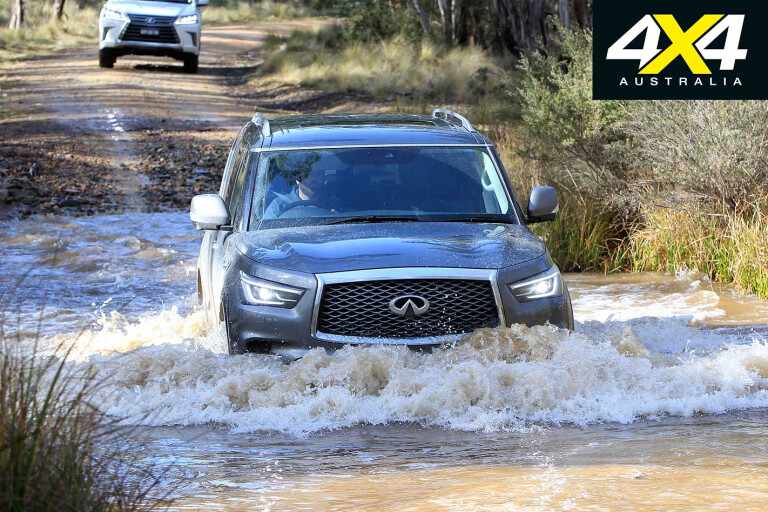
The QX80’s star starts to fade off-road as its deep nose and extended rear bumper significantly eat into the approach and departure angles. Not helping matters, the otherwise brilliant HBMC suspension doesn’t offer any height adjustment, which would help rectify this problem and give a bit more clearance, which the QX80 also needs.
That’s not to say the QX80 doesn’t have anything going for it off-road, as the HBMC suspension provides a surprising amount of articulation, especially for a fully independent system, thanks to the active dampers and lack of travel-limiting sway bars. The QX80 also has a rear locker and brake-force traction control that remains active on the front axle when the rear locker is engaged.
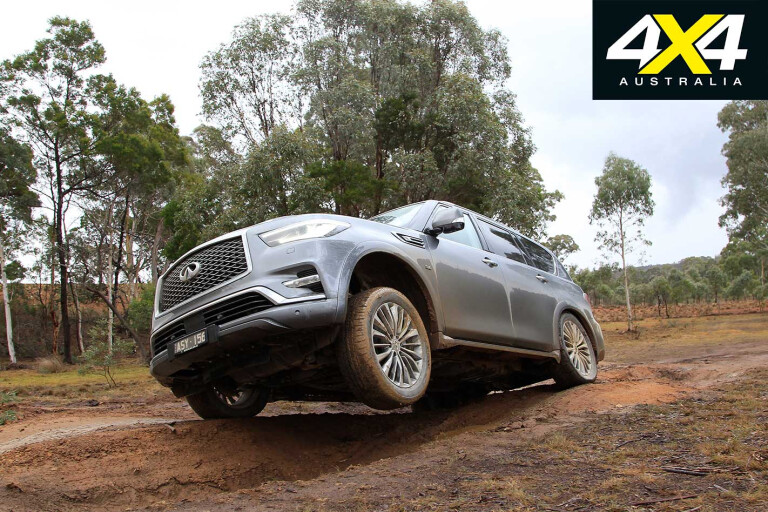
All this means the QX80 can match the live-axle Lexus models for tractive ability, but still needs more all-round clearance to match either LX off-road, both of which enjoy the benefit of height-adjustable suspension.
The QX80 has driver-selectable Sand, Snow or Rock modes available in both high and low range, in a 4x4 system that’s more straightforward to operate than the system in either LX.
Cabin, Accommodation and Safety

The QX80 seats seven people in a cabin that’s the biggest and most spacious in this company. The extra size of the QX80 over both Lexus models is most beneficial in the extra width of the second-row seat and the fact that the third row seat is easier to get in and out of than the third row of the LX570, and more comfortable for adults once you get there. The remaining luggage space when the third-row is deployed is also superior in the QX over the LX570.
The QX80 hasn’t been submitted for ANCAP testing so doesn’t carry a safety star rating. Nevertheless, it has a long list of safety kit (see ‘What You Get’ sidebar) headed by automatic emergency braking.
What you Get

Over and above its donor 4x4, the top-spec Ti-L Patrol Y62, the Infiniti QX80 gains include 22-inch wheels, a Bose audio system with 15 speakers, auto high-beam on/off, power and remote folding second-row seats with heating for outside passengers, power-operated third-row seats and parking assist.
Safety upgrades include automatic emergency braking and reversing collision avoidance. Features carried over from the Patrol Ti-L include six airbags, heated/cooled front seats with memory for the driver, adaptive cruise control, three-zone climate control, an 8.0-inch touchscreen, rear-view camera, sat nav, parking sensors, auto headlights and wipers, tyre-pressure monitoring, external-view cameras, rear DVD entertainment, power tailgate, sunroof, lane-departure and blind-spot warning and crash-mitigation systems, and a rear locker.
Practicalities

The elephant in the room in this three-cornered contest is fuel consumption, and both the QX80 and the LX570 are in the wrong corner of the room. On test the QX80 averaged 18.5L/100km, which was slightly better than the LX570 but still thirsty by any measure.
Making matters worse is that the QX80 loses 40 litres of fuel capacity over the equally thirsty Y62, dropping capacity from 140 to 100 litres. With our on-test fuel average that will only take you 490km if you factor in a 50km ‘safety’ margin. The QX also asks for premium 95RON fuel; although, it does seem to run on lower octane without any obvious issues.
On a more positive practical note, it will take 18s from the Y62 Patrol if you want more country-touring and off-road suitable tyres on the QX80.
LEXUS LX450d
What? A Lexus with a diesel engine? You bet!
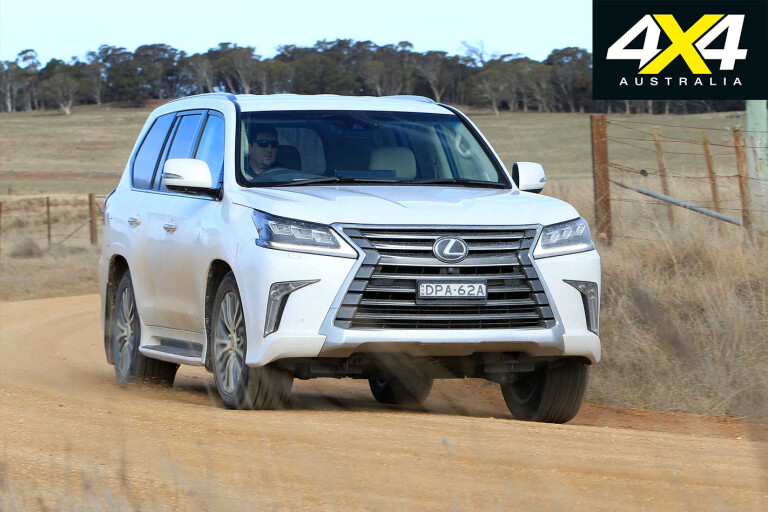
Lexus said it would never make a diesel given a diesel engine’s refinement, or lack thereof, is at odds with the Lexus pursuit of ultimate perfection.
But that was then and now a Lexus with a diesel engine is a reality in the form of this LX450d, with Lexus looking to extend its footprint into the large prestige 4x4 market.
In creating the LX450d, Lexus has taken its already well-established (launched in 2008 and facelifted in 2015) LX570 and swapped its 5.7-litre petrol V8 and eight-speed powertrain for the 4.5-litre twin-turbo diesel V8 and six-speed powertrain of the LC200.
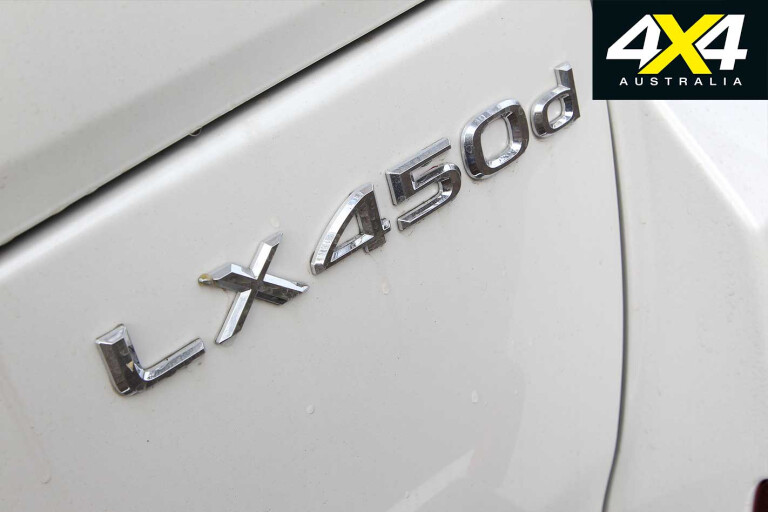
Then Lexus has stripped out the third-row seating, secondary 45-litre fuel tank and some of the petrol-powered 570’s luxury equipment (see ‘What you Get’ sidebar). The 450d’s price tag has also been stripped back $9K from the LX570, which is some recompense.
Powertrain and Performance
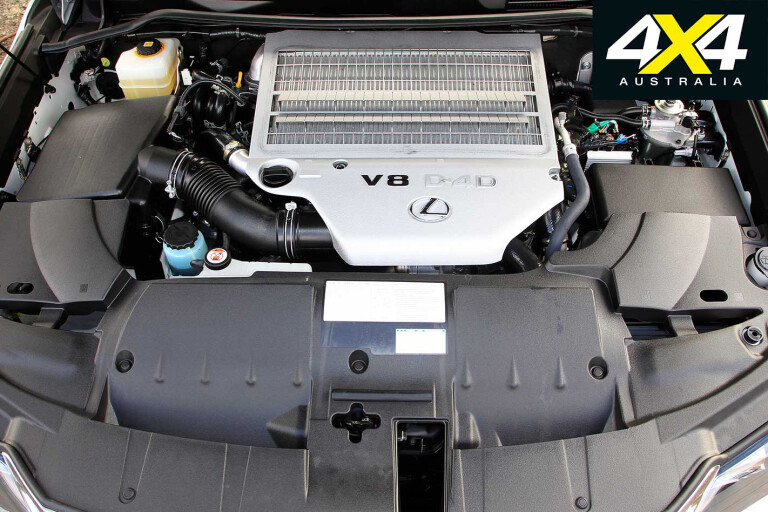
The familiar 4.5-litre twin-turbo V8 diesel from the LC200 claims a 200kW maximum and, while peak torque also remains unchanged from the LC200’s 650Nm, it’s available over a slightly wider rpm range.
Most obvious in the driving is the fact that the big 4.5-litre V8 diesel is much quieter, smoother and more refined in the LX than it is in the latest LC200.
Driven in isolation the LX450d hardly sounds diesel-like at all such is its generally quiet and civil nature, but jump into the QX80, or more so the LX570, and you realise it’s still well short of petrol-engine refinement.
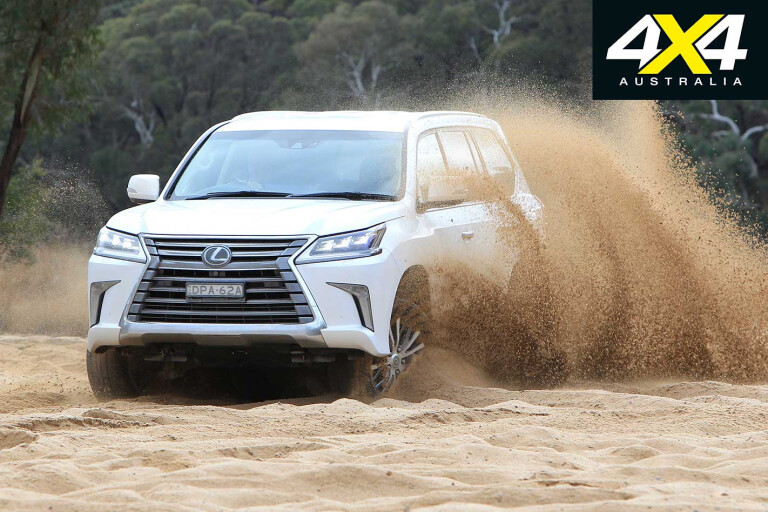
Nor can the LX450d match the performance of the two petrol V8s once they get into their stride; although, in general cut-and-thrust driving, it gives nothing away thanks to the fact that it makes more power at lower engine speeds than the petrol V8s.
What’s more, it does the same job with generally less revs onboard and doesn’t call for a lower gearbox ratio as quickly as the petrol V8s when asked to do some work. The fact that it has less ratios to play with also means less gear changes in general driving.
On-Road Ride and Handling

The LX450d shares the suspension of the LX570 (see ‘Bespoke Suspension’ LX570 sidebar), which means adaptive, interlinked and tuneable damping, variable front spring rate, and hydraulic ride-height control. While there is no KDSS, the general chassis layout with its ladder frame, live rear axle and independent front is based on the Toyota Land Cruiser 200.
Thanks to its sophisticated damping system, the chassis’s response in roll, pitch, ride and steering can be adjusted via the Drive Mode settings’ centre-console dial, which also alters the powertrain’s response.
There are five settings (Eco, Comfort, Normal, Sport, and Sport+) where sharpening up the chassis also sharpens up the powertrain response. Via the dial the driver can also access a preprogrammed Custom setting, where any chassis setting can be matched to any powertrain setting.
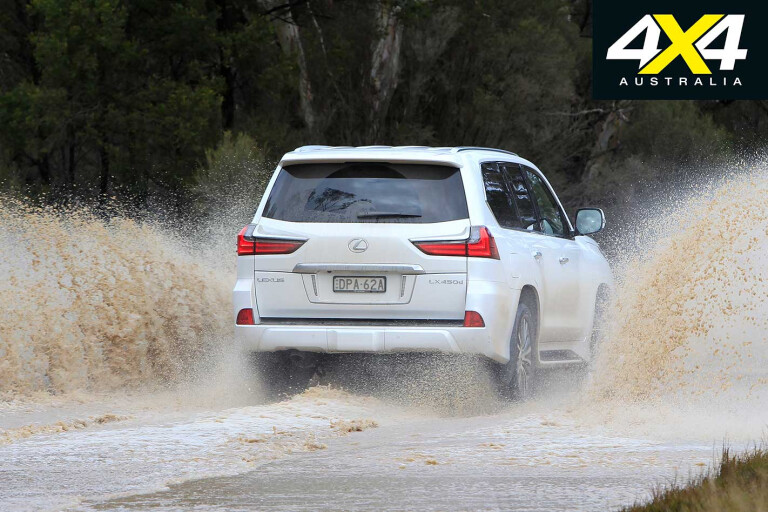
If all this sounds complicated it’s still easy enough to use and, either way, the Custom mode is its saving grace even if it may have been easier just to have separate dials for the chassis and powertrain in the first place.
The 450d, like the LX570, also has variable-rate springing at the front achieved via having the front dampers linked to gas reservoirs, which allows the front suspension to automatically soften up if it suddenly encounters a severe bump in the road.
The LX450d certainly rides smoothly enough, even on its 20s, and offers good body control in terms of roll and pitch. But it’s not as stable on a fast bumpy road as the QX80; although, this may be more to do with its live rear axle than the effectiveness of its adaptive suspension.
Off-Road
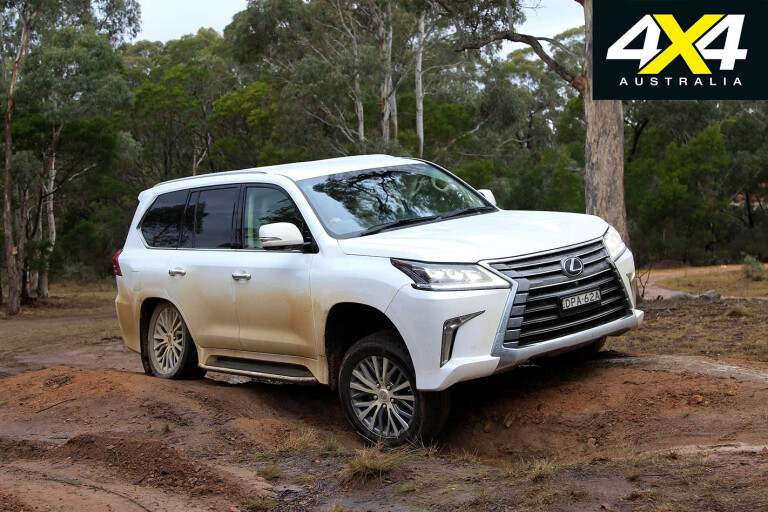
The LX450d’s height-adjustable suspension, shared with the LX570, gives a 50mm lift at the front and 60mm lift at the rear when low-range is selected, or selected directly by the driver. In addition, the suspension will automatically lift another 20mm if the vehicle grounds out while in Crawl mode.
The extra height is most welcome given the LX body compromises the approach and departure angles over an LC200.
The height-adjustable suspension is certainly the difference between the two LXs and the QX80 off-road, and both LXs will go where the Infinti won’t.
Plenty of wheel travel also helps the LX; although, like the LX570, the 4x4 system driver interface could be simpler.
Cabin, Accommodation and Safety
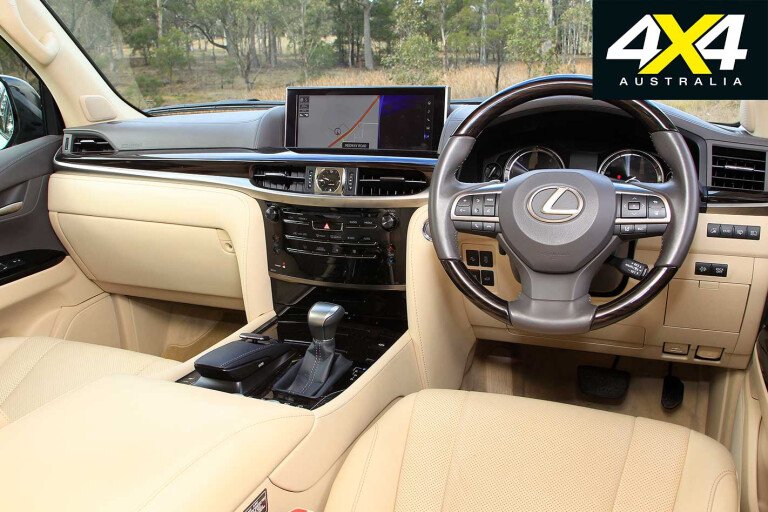
The LX450d is only a five-seater, which could be a deal-breaker for some buyers. The upside is there’s a useful increase in luggage space without the third row seats. As with the 570, the rear seat isn’t as wide as the QX80’s.
The 450d is beautifully detailed and finished inside and more than comfy up front, but misses out on some of the luxury kit of the LX570 and even the LC200 Sahara diesel for that matter (see ‘What you Get’ sidebar). Like the other vehicles here the LX450d hasn’t been ANCAP tested, but that doesn’t mean it’s not loaded with safety kit.
What you Get
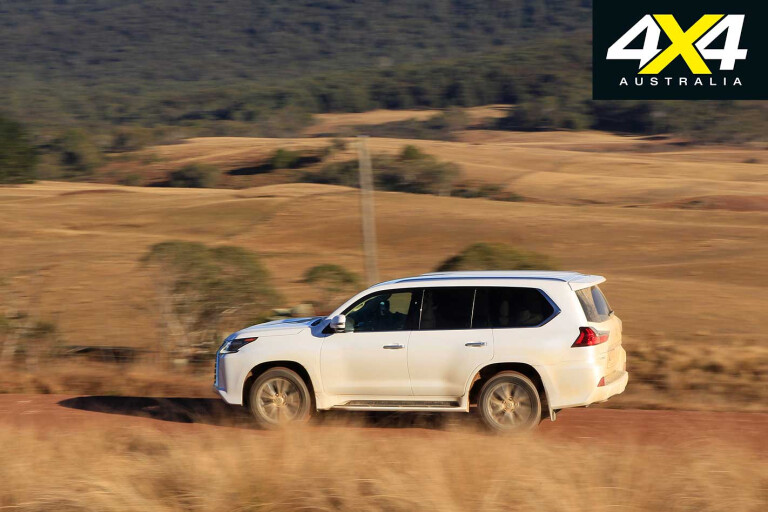
The LX450d’s long list of standard equipment includes radar cruise, automatic emergency braking, memory seats, heated front seats, 10 airbags, LED headlights with auto high-beam on/off, sat nav, a 12.3-inch touchscreen, a nine-speaker audio system, four-zone climate control, a power rear tailgate, tyre-pressure monitoring, selectable ‘Drive Modes’ (see main text), blindspot, lane departure and rear cross-traffic warnings, 20-inch wheels and Multi-Terrain Select and Crawl Control for off-road use.
Compared to the top-spec LC200 Sahara diesel, which is $14K less expensive, it loses third row seating, the sunroof, rear-seat DVD, cooled front seats and 45 litres of fuel capacity. (Equipment differences with the LX570 are listed with the LX570).
Practicalities
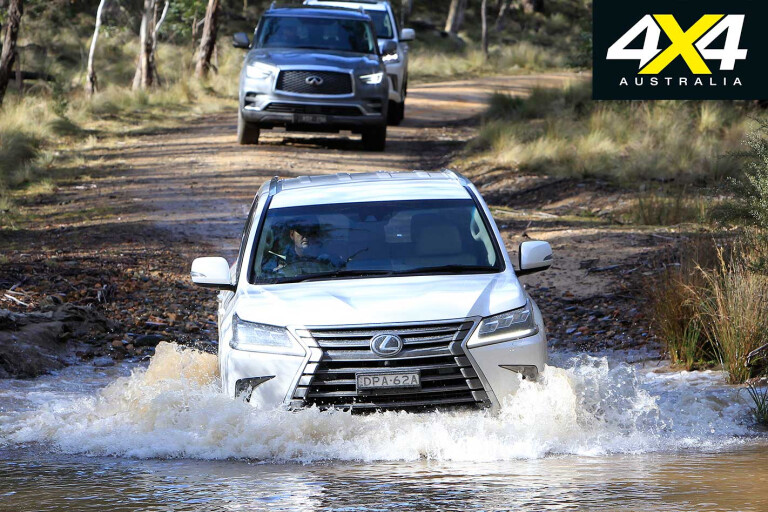
The 450d’s relatively modest fuel consumption (13.8L/100km on test) sets it apart from the two thirsty petrol V8s here. For every two litres of diesel it consumes, the petrol V8s get through nearly three litres of unleaded. The downside is that the 450d has 45 litres less fuel capacity than the LX570 and seven litres less than the QX80. So while it still comfortably betters the Infiniti for range, it doesn’t offer a range advantage over the LX570.
Another practical note (not that Lexus would recommend it) is that the 18-inch wheels from a LC200 will fit, which gives a much wider choice in more practical tyres.
Double Appeal
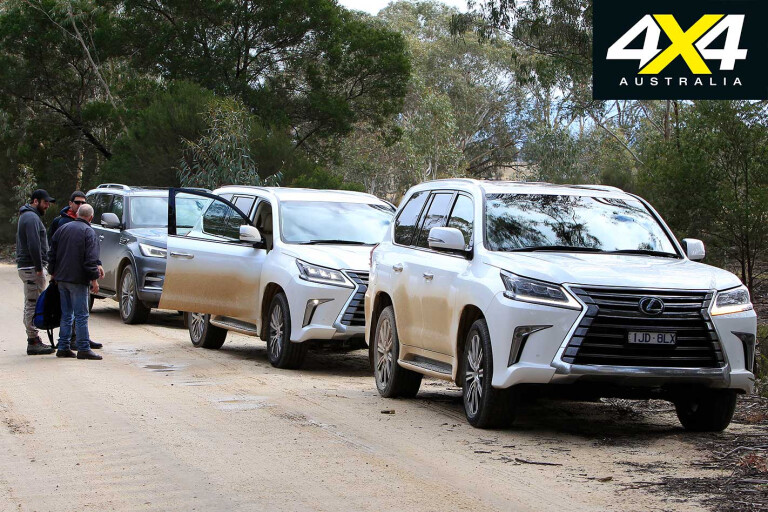
The LX450d is the latest entrant in the top-shelf luxury 4x4/SUV class, known as ‘SUV Upper Large above $100K’ in the official industry sales figures, VFACTS. The 450d joins its petrol stablemate the LX570 and the Infiniti QX80 in that class, along with the likes of Range Rover and the even more highbrow Bentley Bentayga.
The LX450d was launched in April this year and since that time has doubled the total LX sales volume, which year-to-date stands at 198, of which 61 are 450ds. That’s helped push Lexus past Range Rover (with 142 units sold YTD) and into second place in the class, but still well behind the class leader, the Mercedes-Benz GLS, with 529 sold YTD.
LEXUS LX570
The LX570 is the most expensive vehicle here, but does that make it the pick of the trio?

The Lexus LX570 first arrived in 2008 off the back of the then new Land Cruiser 200 Series. It differed from the LC200 in a number of ways, but most significantly with its 5.7-litre V8 not found in the 200. It replaced the previous LX470, which was based on the LC100 and shared its 4.7-litre V8.
In late 2015, the LX570 received a major facelift and features upgrade led by a new eight-speed automatic gearbox, which replaced the previous six-speed auto from the LC200.
The long list of other new standard features included automatic emergency braking, radar cruise control, lane-departure warning, blindspot monitoring, rear cross-traffic alert, head-up display and tyre-pressure monitoring. It also received Drive Mode Select at that time.
Powertrain and Performance
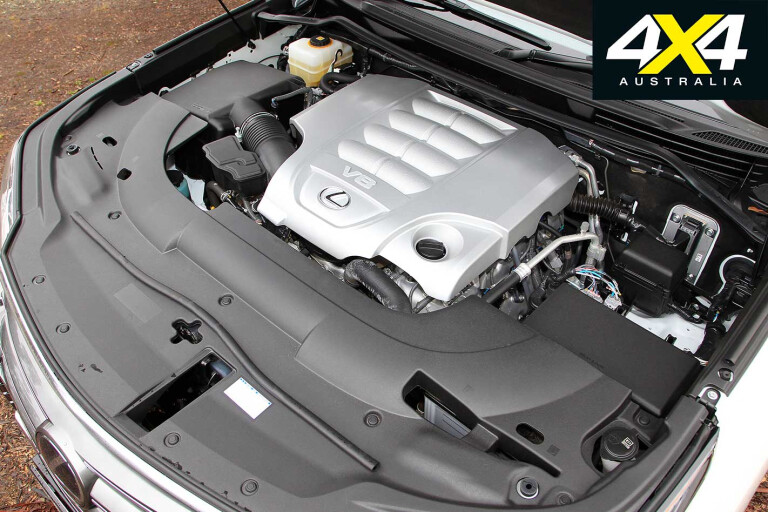
The LX570’s 5.7-litre quad-cam 32-valve V8 features variable valve timing on both cams and direct injection and is the largest engine offered in any Lexus vehicle. Despite being marginally larger in capacity than the V8 in the QX80, it produces less power (270kW vs 298kW) and less torque (530Nm vs 560Nm), but also doesn’t need to rev as hard to achieve its peak figures.
This is an engine of quite different character to the V8 in the QX80. It’s far quieter but also less edgy, urgent and revvy, and goes about its business with zero fuss. If it is refinement and civility you’re after then this engine is the pick of the three; although, it still isn’t short on performance even if it can’t quite match the punchy V8 in the QX80.
The LX570’s eight-speed automatic is also the sweetest and smoothest shifting gearbox of the three, and perfectly complements the refined nature of the naturally aspirated engine.
On-Road Ride and Handling
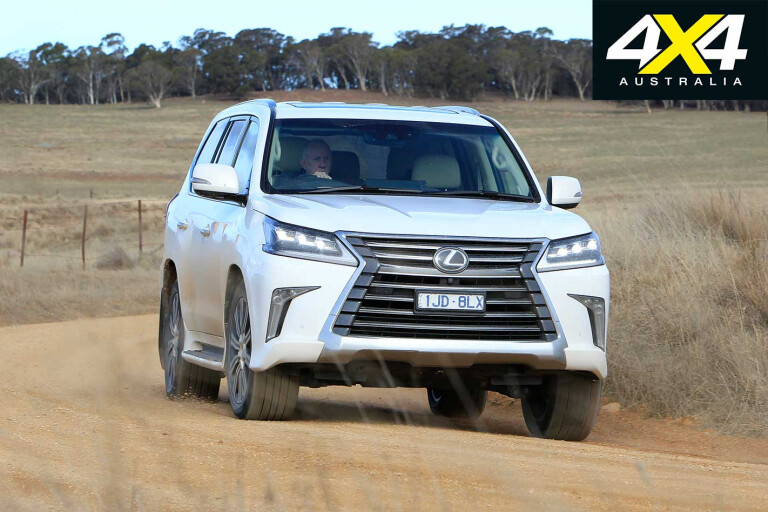
The LX570 shares the unique suspension system of the LX450d, complete with its adaptive damping with driver-selectable modes, automatic adjustment of the front spring rate, and ride height adjustment that automatically lowers the vehicle by 20mm at the front and 15mm at the rear at higher roads speeds.
The LX570, like the 450d, also has variable-ratio steering in place of the LC200’s system with variable hydraulic assistance.
The end result of all this is a compliant, supple and very quiet ride on all road surfaces, even on the 21s that are part of the enhancement pack. The handling and stability on smooth roads is good, too, and Drive Mode Select does its best job here allowing the driver to firm up the damping to reduce the body roll and pitch and sharpen the steering to improve the turn-in characteristics.
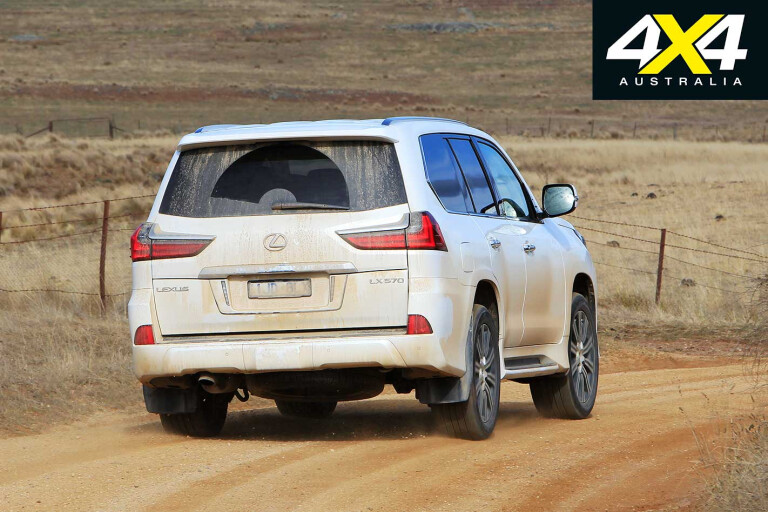
However, like the LX450d, the LX570 is less happy on bumpy roads, especially at higher speeds where there’s a fair bit of bump steer from the rear axle, perhaps even more so than an LC200. Firming up the damping via Drive Mode Select doesn’t help on bumpy high-speed roads.
In fact, on rough roads, both Lexus models handle better in the Comfort mode for the chassis settings. This is where the Custom setting in the Drive Mode Select system comes into play as it allows the driver to pre-program the chassis for Comfort but the powertrain for Power, a combination not available in any of the default factory settings. The steering on both Lexus models is also heavier than the QX80 and doesn’t provide the same degree of feel.
Bespoke Suspension
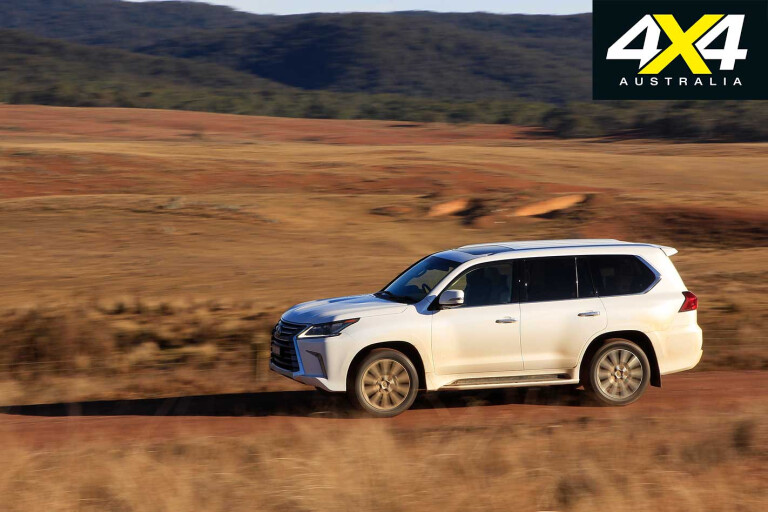
Both Lexus LX models, while sharing the LC200’s basic chassis layout, have unique suspension. Most beneficially they have variable height so they can be jacked-up off-road or lowered at higher road speeds; or lowered further for entry and exit. The LX does this via hydraulics – rather than air springs – using a hydraulic pump connected to all four dampers.
As well as lifting and lowering the LX, the dampers automatically adjust the damping force depending on the bumpiness of the road within Comfort, Normal and Sport modes. The LX’s active dampers also control roll and pitch, which means it doesn’t have the LC200’s active swaybar system known as KDSS.
Off-Road
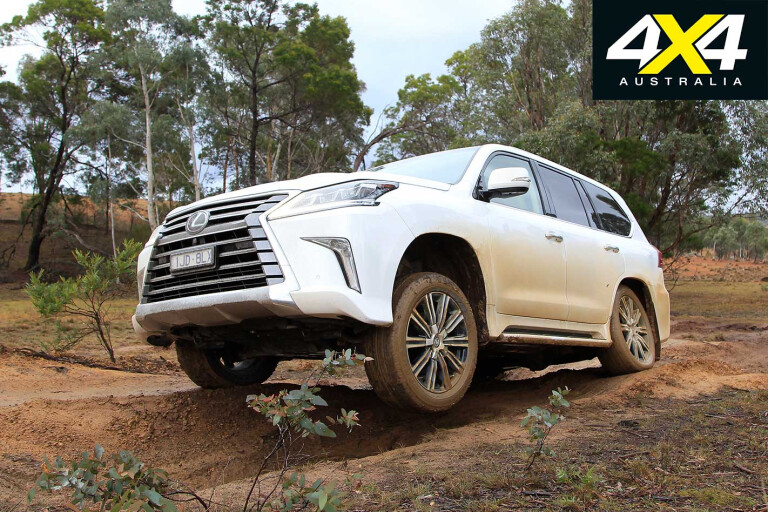
The LX570 largely does what the LX450d does off-road, despite the different power characteristics of the two engines and the fact that the 570’s eight-speed gearbox affords it a better crawl ratio.
The big trick with both, compared to the QX80, is the height-adjustable suspension, but both Lexus models also benefit from the generous wheel travel from the live rear axle. Both also have Multi-Terrain Select, which adapts the powertrain and chassis electronics for different terrain tyres; although, these settings are only available in low range.
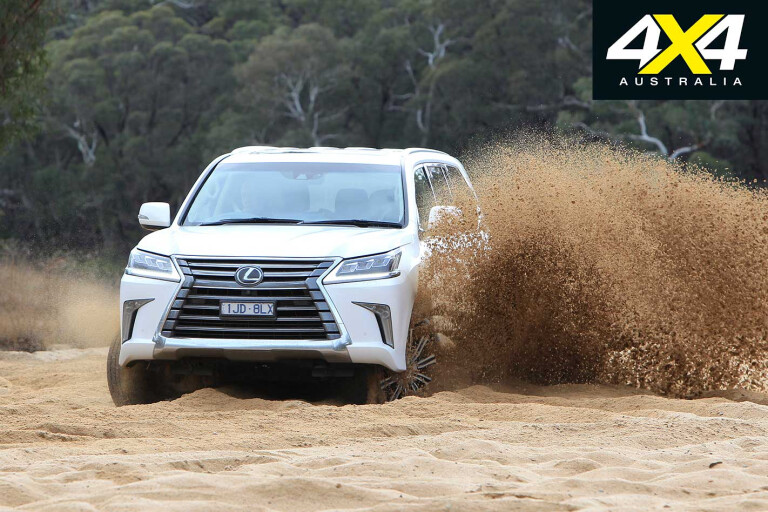
Both also have Crawl Control, which is effectively a low-speed off-road cruise control – although noisy, it’s surprisingly effective in difficult going.
The highest setting for the suspension also only operates when Crawl Control is activated, which means you may need to select Crawl Control when you don’t actually need the automatic throttle control it provides, just the extra clearance if affords.
Cabin, Accommodation and Safety
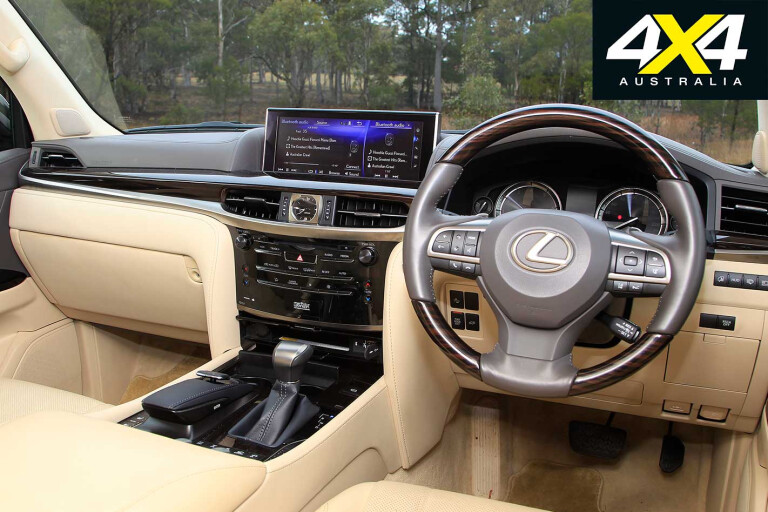
The LX570 seats eight, but the third row seat isn’t as roomy as that of the QX80, or as easy to access. Likewise, the second-row seat isn’t as spacious as the QX’s, especially for three adults.
The LX570 is still a big, comfortable and beautifully detailed and finished wagon with a mind-boggling array of convenience and luxury features, even if some features only come with the optional enhancement pack.
What you Get

The LX570 is notably better equipped than the LX450d and adds a 19-speaker Mark Levinson audio system (rather than a nine-speaker system), twin rear DVD screens, power-fold third-row seats and a sunroof. It also comes with a $16.5K enhancement pack consisting of ventilated front seats, heated second-row outside seats, a heated steering wheel and 21-inch wheels.
Otherwise, like the LX450d, the LX570 has radar cruise, automatic emergency braking, 10 cabin airbags, heated front seats, memory driver’s seat, LED headlights with auto high-beam on/off, sat nav, four-zone climate control, a power rear tailgate, tyre-pressure monitoring, selectable Drive Modes (see main text), blindspot, lane departure and rear cross-traffic warnings, and Multi-Terrain Select and Crawl Control for off-road use.
Practicalities
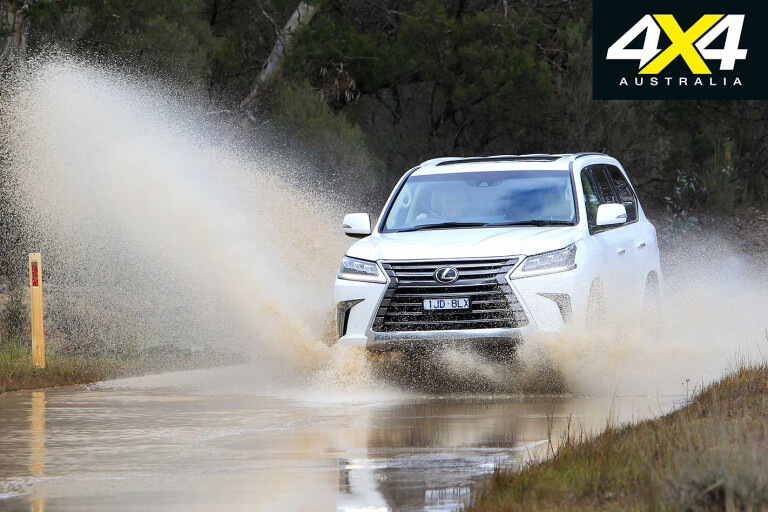
On test the LX570 used 19.4L/100km, which is slightly more than the QX80 – and both have similar (14.4 vs 14.5) ADR fuel-use figures. While both are obviously thirsty, more so than the LX450d, the 570 does have the biggest tank (138L) and is specified to run on 91RON whereas the QX80 asks for 95RON.
Given the LX570 has the same size brakes as the LX450d, it too will take the 18-inch wheels from the LC200 if you want a wider choice with more practical tyres; although, this is not something Lexus recommends.
The Verdict

These three luxury 4x4s present two obvious questions. Firstly, which of the three provides the biggest bang for your buck? Or, in this case, a truck load of your bucks. And secondly, are their prestige badges and extensive equipment lists worth the extra money over their donor vehicles – the LC200 in the case of the two Lexus models and the Patrol Y62 in the case of the QX80?
If you have the money to afford any of these three you may not be concerned about fuel costs, but, either way, the LX450d comfortably provides the best trade-off between performance and economy. It uses two-thirds of the fuel of either petrol V8 yet provides plenty of real-world performance despite lacking the pedal-to-the-metal thrust of the two petrol V8s featured here.
However, no third-row seating could be a deal breaker and, while the reduced fuel capacity over the LC200 Sahara diesel is disappointing, it’s something that can be addressed.
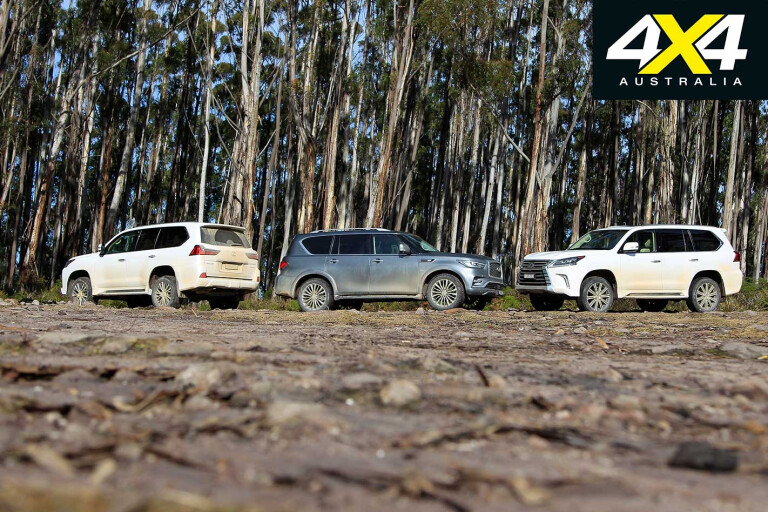
If you’re a keen driver and you’re not concerned about fuel use, then the QX80 is clearly the pick here. It goes the hardest and handles the best. In this company, it’s a driver’s delight. It’s also the least expensive by $24K compared to the LX450d and a whopping $33K compared to the LX570. But it’s also the least useful off-road, so that could be a deal breaker.
It also loses out to its donor car, the Patrol Y62, off-road and in fuel capacity, so if you’re not too fussed about the badge and the extra safety and convenience kit a Ti-L Y62 looks very attractive in comparison.
If you value refinement above all, then the LX570 is the pick. It’s certainly the quietest and most serene driving experience here. It’s also the most removed from its donor vehicle given its 5.7-litre V8/eight-speed automatic isn’t available in the LC200, which is the best justification for its large price tag. If you want a bespoke luxury 4x4, this is the closest you’ll come in this company.

Specifications
| Infiniti QX80 | Lexus LX450d | Lexus LX570 | |
| Engine | 5.6-litre DOHC V8 petrol | 4.5-litre V8 twin-turbo diesel | 5.7-litre V8 DOHC petrol |
| Power | 298kW at 5800rpm | 200kW at 3600rpm | 270kW at 5600rpm |
| Torque | 560Nm at 4000rpm | 650Nm at 1600-2800rpm | 530Nm at 3200rpm |
| Gearbox | Seven-speed automatic | Six-speed automatic | Eight-speed automatic |
| 4x4 System | Dual-range on-demand | Dual-range full-time | |
| Crawl Ratio | 43.9:1 | 34.1:1 | 41.5:1 |
| Construction | Separate-chassis | ||
| Suspension (f) | Independent/coils+HBMC | Independent/coils/VRH | |
| Suspension (r) | Independent/coils+HBMC | Live axle/coils/VRH | |
| Kerb Weight | 2858kg | 2670kg | 2645kg |
| GVM | 3500kg | 3350kg | |
| Payload | 642kg | 680kg | 705kg |
| Towing Capacity | 3500kg | ||
| GCM | 7000kg | 6850kg | |
| Departure angle | 24.5˚ | 20˚ | |
| Rampover angle | 23.6˚ | 23˚ | |
| Approach angle | 24.2˚ | 25˚ | |
| Wading Depth | 450mm | N/A | |
| Ground Clearance | 246mm | 275mm | |
| Fuel Capacity | 100 litres | 93 litres | 138 litres |
| ADR Fuel Claim | 14.5L/100km | 9.5L/100km | 14.4L/100km |
| Price | $110,900 + ORC | $134,500 | $143,160 |

COMMENTS